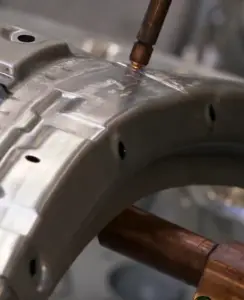 Resistance spot welding, or spot welding is a welding process used to join two or more overlapping metal sheets, studs, projections or another closely fitted surfaces in one or more spots. In this method the joint is produced by the heat generated due to the resistance of work pieces to the flow of current and application of pressure. The weld is limited to the spots on overlapped work pieces and hence not continuous. The pointed copper electrodes conduct the welding current to the work spot and also serve to apply pressure to form the strong joint. These contacting surfaces are heated by a short-timed pulse of low-voltage, high-amperage current to form a fused nugget of weld metal. Small pools of molten metal are formed at the weld area as high current (1000–100,000 A) is passed through the metal. When the flow of current is stopped, the electrode pressure is maintained while the weld metal cools rapidly and solidifies. The electrodes are made of either precipitationed strengthened copper-chromium and/or zirconium alloy and have to be exchanged after a certain amount of welds.
Resistance spot welding, or spot welding is a welding process used to join two or more overlapping metal sheets, studs, projections or another closely fitted surfaces in one or more spots. In this method the joint is produced by the heat generated due to the resistance of work pieces to the flow of current and application of pressure. The weld is limited to the spots on overlapped work pieces and hence not continuous. The pointed copper electrodes conduct the welding current to the work spot and also serve to apply pressure to form the strong joint. These contacting surfaces are heated by a short-timed pulse of low-voltage, high-amperage current to form a fused nugget of weld metal. Small pools of molten metal are formed at the weld area as high current (1000–100,000 A) is passed through the metal. When the flow of current is stopped, the electrode pressure is maintained while the weld metal cools rapidly and solidifies. The electrodes are made of either precipitationed strengthened copper-chromium and/or zirconium alloy and have to be exchanged after a certain amount of welds.
The advantages of the method include efficient energy use, limited workpiece deformation, high production rates, easy automation, and no required filler materials. The principal disadvantage is the need to have accessibility to both sides of the workpiece as opposed to being able to make welds from one side only. The most commonly used welding methods for automotive applications include resistance spot welding (RSW). The vehicle manufacturing industry, among others, employs the resistance processes extensively in applications in which the product design specifies gauge thicknesses that are lapped. Fully automatic and robotic systems are used for many of these applications. The conventional steel body of a car, on an average, contains 4500 spot weld joints.
We hope, this article, Resistance Spot Welding – RSW, helps you. If so, give us a like in the sidebar. Main purpose of this website is to help the public to learn some interesting and important information about materials and their properties.